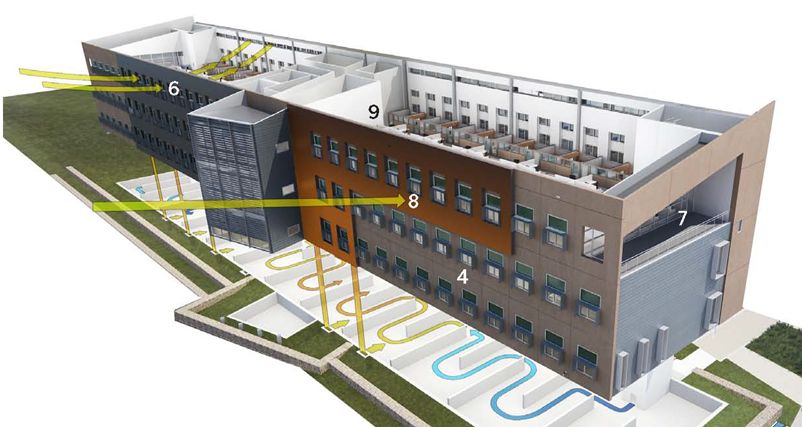Author – Saurabh Khanna
Smart devices that can communicate with one another through the internet of things (IoT), right from wearable accessories, to intelligent cars, to smart energy meters are the buzzword these days. Most of these IoT electronic devices are not installed at home or on phone—they are in factories and commercial buildings. They are used for validating vital data, reducing costs, handling manpower, increasing efficiency and optimizing bottom-lines.
The internet of things has already started infiltrating areas of our life that we probably never even thought of, like sports, clothing and even buildings. McKinsey & Co estimates the IoT technology market could be worth up to $11.1 trillion per year by 2025. By 2025, the total global worth of IoT technology could be as much as $6.2 trillion.
Defining Smart Buildings

Modern buildings contain complex mechanical devices, sophisticated control systems and a suite of features to improve the safety, comfort and productivity of occupants. Most of these systems involve machine-to-machine communication, but since the data is general in nature and the communication protocols are proprietary, information only flows along certain paths.
A smart building will require seamless connectivity among all the equipment and systems in a building. A good example is data center optimization, which boosts the efficiency of a company’s IT department by incorporating information about humidity, temperature and lighting, along with data on any unauthorized intrusion. Similarly, data from a building security system can be used to turn off lights and reduce cooling when most occupants leave the building. This could help in analyzing post-productivity hours and curb costs.
Smart buildings require cooperation among different competing service providers who have to enable inter-operable, connected devices and systems within a building. That means creating an automatic centralized control of a building’s heating, ventilation and air conditioning, lighting and other systems through a building management system. Once such seamless connectivity happens among all the equipment, then it will result in a smart building where lighting, air conditioning, security and other systems exchange data freely – leading to higher efficiency, more safety, better comfort, and a lower cost of operations.

Let us check the areas where IoT can be used to make a building smarter one:
- Data Center – boosts the efficiency of the IT department by incorporating information about humidity, temperature and lighting along with data on any unwanted intrusion.
- Energy Consumption – Based on Big-Data reports it is easy to know the ‘Ghost-Loads’ and areas where to curb costs on energy consumption.
- Building Maintenance – Analysis algorithms can detect problems in performance before they cause expensive outages, leading to optimum efficiency.
- Device-level Monitoring – If device-level monitoring is done and pro-active alerts are given by IoT-enabled devices, then major cost reduction can be achieved in device outages and repairs.
- E-surveillance – Organizations provide ‘Smart-Cameras’ with motion sensors, cross-line detection and many other important features that give pro-active alerts/alarms even before an untoward incident takes place.
Smart buildings around the world

Let us look at some of the smarter buildings around the world that have gone net-zero energy and beyond, by finding the nexus between ecological integrity and human well-being:
- Deloitte HQ in Amsterdam – The Edge features a highly efficient aquifer thermal energy storage system, a water-efficient trickle-down, rainwater toilet water system and a human-powered gym!
- Glumac in Shanghai – features an indoor air monitoring system that allows employees to see the toxicity of indoor air on their cell phones.
- DPR Construction in San Francisco – equipped with solar photovoltaic panels, rooftop solar thermal water heating, intelligent electro-chromic windows, ultra-energy efficient ceiling fans, and a living horticulture wine bar.
- The Bullitt Center in Seattle – features include net zero energy, net zero water, net zero carbon, composting toilets, toxic-free materials, and using 80% daylight through high-performance windows. While the world’s only six-storey composting toilet system is impressive, even more impressive are the 575 solar panels on top, proving that it is possible to go net zero energy via solar!
- Clover Network in Sunnyvale – possesses 86 smart windows that tint dark on demand and respond intuitively to outside conditions.
- NREL Research Support Facility in Colorado – has a large thermal labyrinth that passively redistributes heat from sunny south-facing facades into other parts of the building, dramatically lowering the cooling load of the building’s data center.
- Legion House in Sydney – Air conditioning is provided by using chilled beam technology, which uses 100% fresh outside air to maintain indoor environment quality.
Smart buildings in India

Apart from these global smart buildings, there are some Indian counterparts that have made some space in the intelligent building category. Building automation provider Honeywell has created a ‘Smart Building Score’ in which some 2,000 buildings across India were surveyed and a few got space in the top ranking. Honeywell’s survey showed that targeted investment in smart buildings can drive economic and environmental benefits, protect human life, safeguard building assets, and support India’s goal to develop 100 Smart Cities.
Honeywell found that airports and hotels are the smartest buildings in India with an average Smart Building Score of 49 and 41 respectively. Indira Gandhi International Airport in New Delhi was voted the Smartest Building in India, which has consistently improved its commitment by winning this same award for three consecutive years. The IGI Airport also captured the awards for being the Smartest Airport Building, as the Greenest, the Safest, and the Most Productive Building in India.
Similarly, Infosys’ Software Development Building in Pune won the Smartest Single Occupant Private Office award. Bangalore has invested the most in smart buildings (57%), potentially owing to newer construction, while Mumbai can do more (36%). So to cut the long story short, if smart connected devices are deployed in buildings, they can result in a huge reduction of costs, and an increase in profits and productivity, making buildings smarter.

